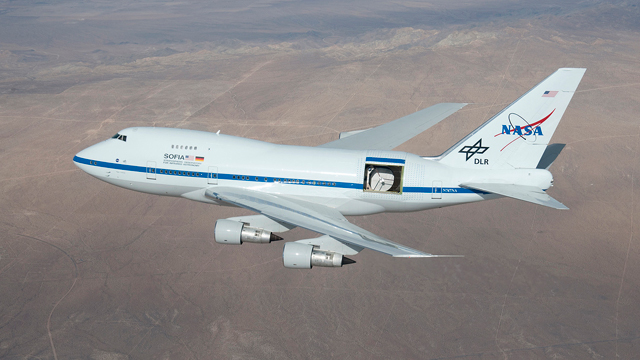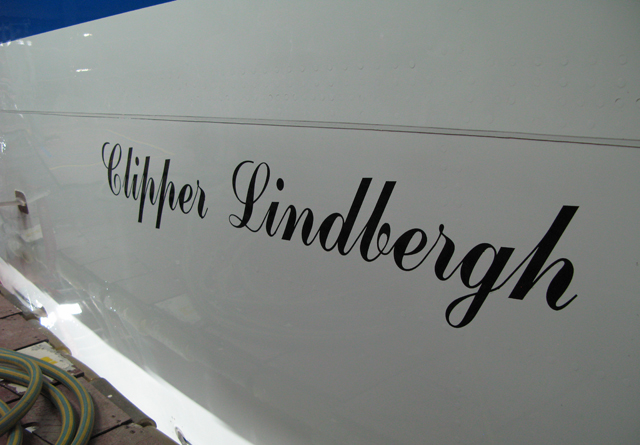Inside a Hamburg maintenance hangar belonging to Lufthansa Technik (LHT), a 40-year-old Boeing 747 Special Performance is undergoing a heavy check to help keep the heavily modified, NASA-owned aircraft in service until 2034.
The quad-jet – which was originally delivered to Pan Am in 1977 – is equipped with a 17t infrared telescope in the rear fuselage to conduct frequent long-haul space observation flights as part of a joint project between NASA and German aerospace research centre DLR.

Lufthansa Technik
Unlike light that is visible to the human eye, infrared radiation from space shows the existence of interstellar molecular and dust clouds. How these clouds form the basis for stars and planetary systems and how Milky Way systems develop is a central objective for the programme dubbed Stratospheric Observatory for Infrared Astronomy (SOFIA).
Ground-based observation is impractical as humidity in the atmosphere disturbs the infrared radiation. The 747SP was specifically selected for the project, because the shortened, lighter long-haul variant can fly higher than other 747s.
Observatory flights are operated at altitudes of 39,000-45,000ft and last about 8-10h, said DLR’s SOFIA project manager Heinz Hammes during a media briefing in Hamburg on 15 December. Some 110 sorties are typically conducted each year, he says.

NASA
To operate the telescope – featuring a 2.7m (9ft)-diameter mirror to collect and direct the infrared radiation to measuring equipment – the aircraft has been modified with a 4m by 6m door on the port side, forward of the tail fin. An additional pressure bulkhead has been installed forward of the telescope compartment.
Hammes says the door can be opened at cruise speed of Mach 0.85 and that there is no noticeable change in the aircraft's behaviour when the door is open. Pilots report that it flies like any other 747, he says.
He likens the observatory's visual capability to installing a telescope on the back of a truck and being able to distinguish a fly's individual eyes from 3 miles (5km) away, while driving along a motorway.
The 747's slightly oval fuselage cross-section has been reshaped around the telescope compartment – firstly to allow the new door to slide up across the fixed roof structure and, secondly, to direct the airstream on to the horizontal and vertical stabiliser without disturbance.

Lufthansa Technik
DLR says there is comparatively limited turbulence inside the telescope compartment during cruise, with windspeeds averaging around 60kt (110km/h), says Hammes. The temperature inside the compartment "surprisingly" does not drop below -35°C (-31°F) despite outside an air temperature of around -60°C.
The door surround structure has been heavily reinforced and certain systems – including the mechanical control cables for the horizontal stabiliser and rudder, which normally run through the fuselage crown and therefore had to be redirected – required modification. But LHT says that the telescope door has not created additional inspection tasks for the rest of the airframe structure.
Sourcing spare parts for the legacy aircraft is a task in its own right, however. LHT project manager Sven Hatje notes that several parts have been specifically designed for the 747SP. This includes a single-slotted trailing-edge flap system that is entirely different to the triple-slotted arrangement on the original 747 from which the SP was developed. The 747SP also has a higher and thicker tail fin with a double-hinged rudder, versus a single-hinged rudder on standard-length versions.
Hammes says NASA has sourced two other 747SPs for parting out and will add a third to the inventory soon. Boeing built 45 747SPs, and Flight Fleet Analyzer shows that nine remain in service.
LHT – which says it is the only European maintenance provider that is capable of servicing the type today – is supporting two VIP-configured 747SPs, but Hatje says NASA flies its aircraft "much more" than the VIP operators.
In order to ensure sufficient engine supply for the Pratt & Whitney JT9D-powered aircraft, NASA and DLR have together purchased 16 engines. Hammes notes that wear and tear on the powerplants is "quite high" as the aircraft is operated at high altitude.
An area that requires frequent attention is the air conditioning system. While the cabins of regular passenger aircraft need cooling in flight – despite the low outside temperature – as passengers give out body heat, NASA's 747SP needs heating as there are only up to 30 people on board. One of the flight engineer's key tasks is to continuously readjust the temperature on board, says Hammes. But LHT project manager Stefan Babel points out the air ducts are not designed for excessive heating and thus require more maintenance than usual.

Michael Gubisch/FlightGlobal
While the aircraft seems destined to become the oldest flying 747SP with another 17 years of planned service for the SOFIA programme, NASA has made an effort to honour the aircraft’s origins. When it was delivered to Pan Am, it was christened – in the former carrier's tradition – Clipper Lindbergh by the US aviator's widow.
The aircraft became part of United Airlines' fleet in 1986 – when that carrier acquired part of Pan Am's operations – and was put in storage in 1994. But when NASA returned it to service, the agency returned the name to the aircraft and this time invited Charles Lindbergh’s grandchild to the christening.
Source: FlightGlobal.com



















